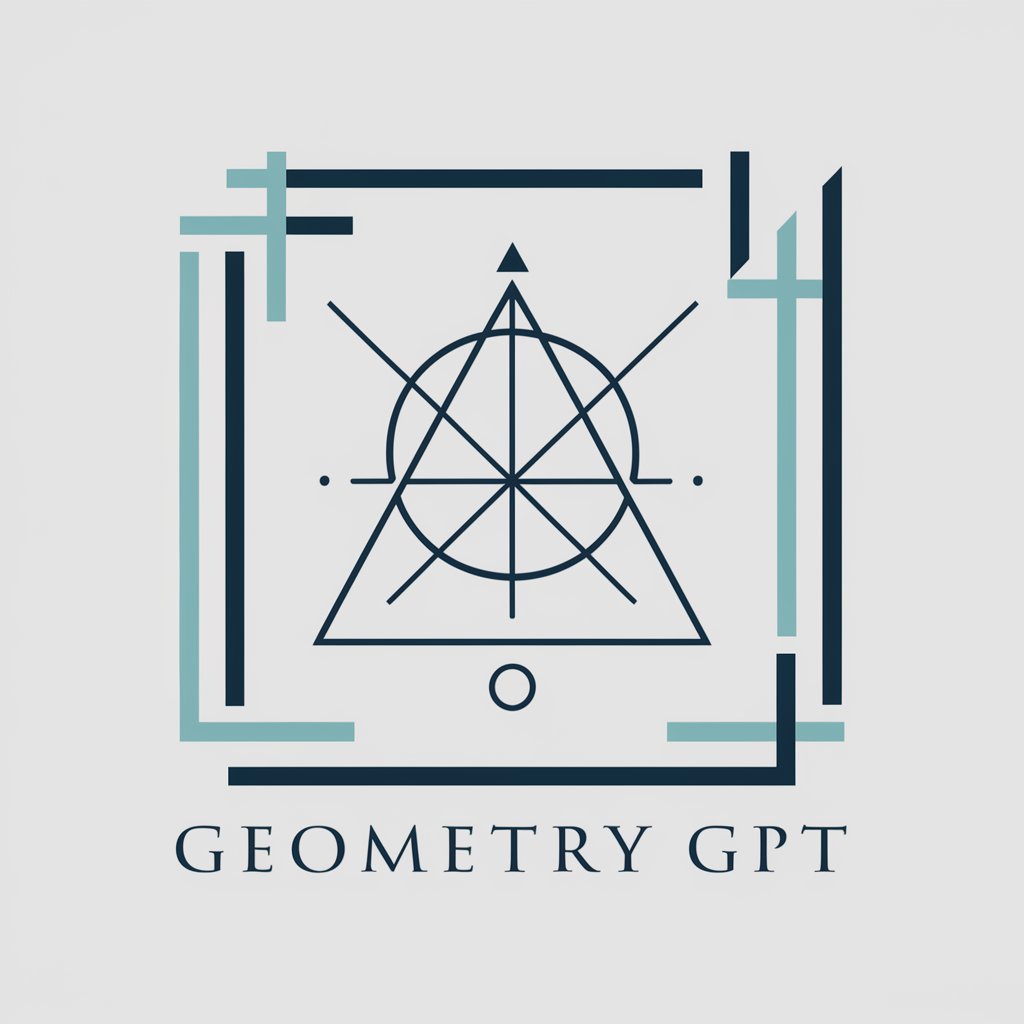Geometry - Interactive Geometry Exploration

Welcome to Geometry GPT, your guide to the world of geometric shapes and concepts.
Solving Geometry with AI-Powered Precision
Can you explain the properties of a
What are the differences between
How do you calculate the area of
Describe the characteristics of
Get Embed Code
Introduction to Geometry
Geometry is a branch of mathematics that deals with the properties, measurements, and relationships of points, lines, angles, surfaces, and solids. It is fundamentally concerned with space and form, encompassing a wide range of shapes and figures. The field of geometry is divided into two main branches: Euclidean geometry, which studies flat surfaces and is most familiar to students through the study of shapes like triangles, circles, and polygons; and non-Euclidean geometry, which explores surfaces and spaces that are not flat, such as those curved by gravity in the theory of relativity. Geometry serves as a foundational element in many fields, including architecture, engineering, computer graphics, and physics, providing essential principles for design, analysis, and problem solving. For example, in architecture, geometry is used to determine the best spatial arrangements and shapes for buildings, ensuring both aesthetic appeal and structural integrity. In computer graphics, geometric algorithms are crucial for rendering realistic three-dimensional scenes. Powered by ChatGPT-4o。

Main Functions of Geometry
Spatial reasoning and problem solving
Example
Determining the most efficient design for a piece of land to maximize its use without violating zoning laws.
Scenario
An urban planner uses geometric principles to allocate space for residential, commercial, and recreational areas in a new development.
Measurement and properties of shapes
Example
Calculating the area of irregular land parcels to determine property taxes.
Scenario
A land surveyor applies geometric formulas to assess the size and boundaries of various properties for legal and construction purposes.
Optimization and design
Example
Designing the layout of solar panels on a roof to maximize sun exposure while fitting within physical constraints.
Scenario
An engineer uses geometric analysis to calculate angles and positioning that optimize energy efficiency for renewable energy projects.
Visualization and representation
Example
Creating three-dimensional models of new car designs for aerodynamic testing and visual appeal studies.
Scenario
Automotive designers utilize geometric modeling software to simulate and refine vehicle shapes before physical prototypes are built.
Ideal Users of Geometry Services
Students and Educators
Students from elementary to university level, along with their educators, form a primary user group. Geometry helps students develop critical thinking and problem-solving skills through the exploration of shapes, sizes, and the properties of space. Educators benefit by using geometric concepts to teach and illustrate mathematical principles in a tangible and engaging way.
Professionals in Design and Engineering
This group includes architects, engineers, urban planners, and designers who apply geometric principles to create, analyze, and optimize physical structures and spaces. Geometry assists them in ensuring that designs are both functional and aesthetically pleasing, adhering to necessary specifications and constraints.
Scientists and Researchers
Researchers in fields such as physics, astronomy, and materials science use geometry to model theories, conduct experiments, and analyze data. For instance, astrophysicists rely on geometric calculations to understand the structure of the universe and the movement of celestial bodies.

Guidelines for Using Geometry
Start Your Journey
Begin by accessing yeschat.ai to explore Geometry without the need for registration or ChatGPT Plus, offering a hassle-free trial.
Identify Your Needs
Determine your specific geometry-related queries or problems, such as understanding shapes, solving problems, or visualizing geometric concepts.
Engage with the Tool
Utilize the Geometry tool by inputting your questions or problems. Make use of diagrams or mathematical notation if the platform supports it.
Explore Resources
Leverage any available tutorials, examples, or documentation to enhance your understanding and usage of geometric principles.
Apply and Practice
Apply the concepts learned in practical scenarios or exercises. Regular practice is key to mastering geometric principles and problem-solving.
Try other advanced and practical GPTs
Tile
Expert Tile Insights at Your Fingertips

Eksamensudvikling- og evalueringsGPT
Empowering educators to create AI-proof assessments

Wedding Shower
Streamlining your shower with AI

HVAC
Empowering HVAC Solutions with AI

成满
Empowering Decisions with AI Insight

SEO Content Crafter
Craft SEO-Driven Content Effortlessly

Home Teacher Mr. Bot
Empowering education with AI quizzes

Kosher
Empowering Kosher Compliance with AI

Marketing
Empowering your marketing with AI

遥人夢川(Haruto Yumekawa)
Bridging languages, connecting cultures.

Nails
Empowering your nails with AI

Workflow Buddy
Streamlining Professional Tasks with AI

Frequently Asked Questions About Geometry
What is Geometry?
Geometry is a branch of mathematics that deals with the study of shapes, sizes, properties of space, and the relationships between different figures. It involves understanding and solving problems related to angles, lines, surfaces, and solids.
How can Geometry help in real life?
Geometry has practical applications in many areas including architecture, engineering, art, design, and everyday problem solving. It helps in planning and constructing buildings, creating art, understanding spatial relationships, and solving various practical problems.
What are the types of Geometry?
There are several types of Geometry, including Euclidean (deals with plane and solid figures), Non-Euclidean (explores spaces that are not flat), and Analytical Geometry (uses algebra to describe geometric principles).
How does Geometry integrate with other subjects?
Geometry integrates closely with subjects like physics, engineering, and art, providing a mathematical framework to describe and solve problems in these fields. It also connects with algebra and calculus in Analytical Geometry and provides tools for statistical analysis and computer graphics.
What are the basic concepts in Geometry?
Basic concepts in Geometry include points, lines, planes, angles, circles, triangles, quadrilaterals, polygons, and solids. These elements are the foundation for understanding more complex geometric principles and relationships.
